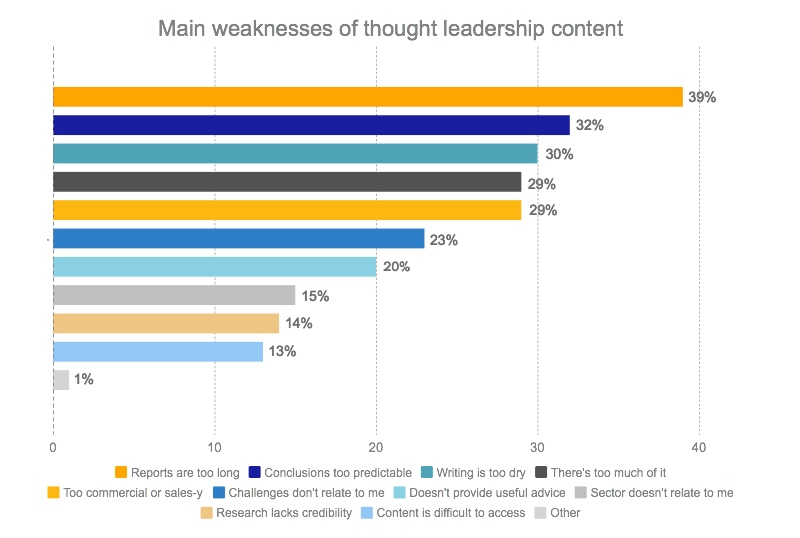FT Longitude insights: The top 5 reasons thought leadership fails
We hear many reasons cited anecdotally why executives may be turned off by a piece of thought leadership: it’s too long; it doesn’t address their specific business issues; it’s too sales-focused – the list goes on. But what is it that really turns audiences on to – or off – thought leadership content?
Our new research, ‘The power of thought leadership’, puts some hard data behind these theories.
In our previous post, we shared insights into what executive audiences really think about thought leadership content, based on the findings of this global research. In this post, we reveal the top five reasons why thought leadership fails to hit the mark, according to the executives we asked, and we share our recommendations for how to get it right.
Our respondents told us that the top five pitfalls of thought leadership content are:
- Reports are too long
- The conclusions are too predictable
- The writing is too dry or bland
- There’s too much of it
- It’s too commercial or ‘sales-y’
We asked respondents, ‘What do you consider to be the main weaknesses of thought leadership/B2B content?’

Source: The power of thought leadership survey, FT Longitude Research, July 2016
Avoid the pitfalls
As our survey found, audiences want original, evidence-based points of view that allow them to have better conversations with their clients and partners – they do not want sales materials. And these content-overloaded audiences recognise a sales pitch from a mile off; they will not engage if they think they are getting the hard sell.
Rather than single-mindedly pushing their own messages, content producers must be prepared to contribute to their industry’s conversations more broadly. This is what establishes an organisation as a valuable voice – a thought leader.
But it is equally important not to churn out content simply to join the conversation. Unless an organisation has something to say – a clear, preferably brand-new point of view with a strong conclusion and actionable insights – there is no point saying it. To do so only makes it harder to engage your audience when you actually do have something new to say.
So, on a more positive note, what advice do consumers have for producers of thought leadership?
They told us:
- “Brevity is best”
- “Focus on the real-life needs of your readers”
- “Make it insightful, readable and digital”
- “It should be balanced, authoritative and succinct”
- “Create sector- and region-specific content based on future market trends”
- “Use more case studies – go deep on how the team implemented the solution and made it stick”.
How to get it right
Keep it brief. Audiences want shorter articles, not lengthy reports. Although traditional, long-form content still has its place, most readers are time-poor and want concise content that gets the message across quickly and clearly.
Use real-life examples. Audiences want stories that resonate with them — not abstract theories. This is why case studies are so popular among our respondents.
Make it visual. Infographics are a pithy way to get a message across, and the executives we surveyed love them.
Have an opinion. Good thought leadership gives an evidence-based point of view on the topics that keep clients awake at night. Often, however, companies are scared of expressing a strong point of view. Our research shows just how receptive audiences are to original insight: 63% agree that the best thought leadership is genuinely provocative. Without taking a stand, organisations will find that their content does not resonate.
Make it relevant. 73% of business leaders tell us they want content that is specific to their sector. This makes sense: the dynamics in financial services, for example, are very different from those in life sciences. Cross-sector content is often too diluted, and the real factors driving opinion among business leaders become blurred as a result. ‘Cutting up’ the insights to make them sector-specific enables companies to produce more assets and extract even greater value from their thought leadership investment.
We believe thought leadership is one of the most powerful instruments in a marketer’s toolkit – but only if you get it right. A strong thought leadership strategy will bolster brand credibility, highlight your expertise, create new conversations and raise your profile in the media. So why settle for anything less?
Click here to access the full findings of the research via our online report.






 Back
Back

 Book a meeting
Book a meeting
 Book a meeting
Book a meeting

